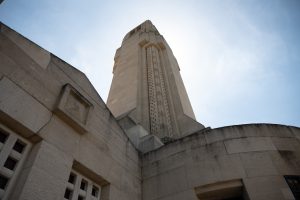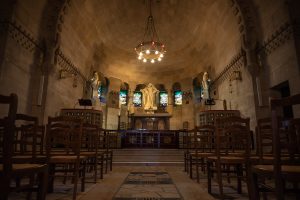
At the end of 1918, thousands of bodies were discovered in Verdun. Charles Ginisty, Bishop of Verdun, decided to gather the bones of the unidentified soldiers in a place of remembrance. As a result, the building was inaugurated in 1932. Thus,130,000 soldiers from all walks of life are buried in the ossuary. In addition, 15,000 French soldiers were buried in the graves in front of the monument.
Today, inside the sanctuary, almost 4,000 engravings of the names of soldiers who died at Verdun cover the walls. From the top of the monument at nightfall, a light visible from 40km away watches over the thousands of soldiers who were not found on the battlefield.
At the beginning of your visit, you can watch a short film about the Battle of Verdun and the monument’s history. The cinema room of the ossuary also hosts occasional conferences and symposiums.

After visiting the abbey, a chapel welcomes visitors who wish to meditate. The stained glass windows represent scenes related to the war: a Frontsoldaten (a front line soldier), a nurse, and a battlefield panorama. Their very expressive faces remind us of the importance and intensity of the reality of the First World War. Today, the founders of the shrine are buried in the chapel.
There was a strong desire to bring together all combatants, regardless of their nationality, division, position or religion. While it is true that the project included chapels for each religion. The Protestants did not wish to take their place. The Israelites erected their own monument in 1938 and it was not until 2006 that a monument dedicated to Muslim soldiers was erected.
The 46-metre high ossuary tower, also known as the ‘Lantern of the Dead’, offers a magnificent view of the battlefield. In addition, there is a scene depicting the lives of the soldiers on both sides.